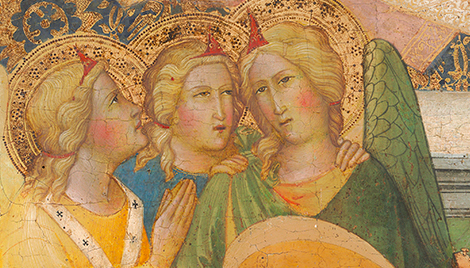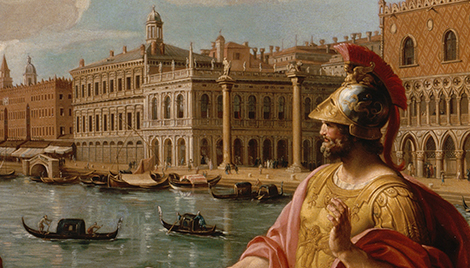Double Feature: "Medieval Money" and "Morgan’s Bibles" at the Morgan Library & Museum
Two exhibitions supported by the Kress Foundation are currently on view at the Morgan Library & Museum in New York: Medieval Money, Merchants, and Morality (November 10, 2023–March 10, 2024) and Morgan’s Bibles: Splendor in Scripture (October 20, 2023–January 21, 2024). Both exhibitions draw on strengths of the Morgan’s collection of manuscripts and early printed books, among other exceptional objects, and explore diverse themes pertaining to collecting, religion, trade, money, personal values, and more.
—
Hieronymus Bosch, Death and the Miser, Oil on panel, The Netherlands, ca. 1485–90; National Gallery of Art, Washington DC, 1952.5.33, Samuel H. Kress Collection;
Strongbox, Steel, Germany, late sixteenth or early seventeenth century; The Metropolitan Museum of Art, New York, 1890, 90.13.1;
Coins of the Chalkis hoard, Greece, Chalkis, late fourteenth century; American Numismatic Society, New York, 1985.58
In the second-floor galleries of the Morgan, Medieval Money, Merchants, and Morality explores themes of commerce, trade, wealth, morality, and their intersection with the visual arts from the Middle Ages to the early Renaissance. The exhibition opens with a triangulation between three objects: a cluster of low-value Venetian coins from the late-fourteenth century; a large, steel strongbox on loan from the Metropolitan Museum of Art; and Hieronymous Bosch’s famous, Kress Collection painting, Death and the Miser (ca. 1485–90), now in the collection of the National Gallery of Art. Viewed as a group, Bosch’s scene of a miser on his deathbed, lamenting the loss of his material wealth upon his impending death, comes to life. This grouping of objects speaks to many themes present in the exhibition, in particular the tension between Christian ideals, spiritual fulfillment, and material success.
A second Kress Collection painting included in the exhibition, Andrea di Bartolo’s Joachim and Anna Giving Food to the Poor and Offerings to the Temple (ca. 1400–1405), portrays the Christian ideal of charity in action. In a rare depiction of tithing—a practice where one-third of ones income is given to the poor, one-third is given to the Church, and one-third is kept for oneself—the Virgin Mary’s parents, Anna and Joachim, are shown giving bread to the poor and elderly, and grain to the Temple in Jerusalem.
Andrea di Bartolo, Joachim and Anna Giving Food to the Poor and Offerings to the Temple, Oil on poplar, Italy, Siena, ca. 1400-1405; National Gallery of Art, Washington, DC, 1939.1.43, Samuel H. Kress Collection
Other fascinating objects on view include...
Deathbed and Purgatory from “The Hours of Catherine of Cleves,” Illuminated by the Master of Catherine of Cleves, The Netherlands, Utrecht, ca. 1440; MS M.9617/945, P. 180-Fol. 97R
"A dying man, tucked in bed, is offered a candle by his wife while we waits for a priest to perform Last Rites... Near the doorway, the dying man's son convenes with an aquaintance who may be encouraging him to seize his inheritance."
Punishment of Usurers, Dante Alighieri, Divina commedia (Divine Comedy), Italy, Florence, 1345–55; MA M.676, Fols. 26V-27R
“This prized early manuscript of Dante’s Divine Comedy, a work completed by the author around 1321, shows evidence of frequent use, including candle drippings and notes jotted between lines in the margins… In the lower-left image, naked usurers are punished with a rain of fire… Florence was a flourishing commercial center, but many, including Dante, condemned those who charged interest on loans as exploiters of the poor.”
St. Anthony in the Desert and St. Louis Giving Alms from “Prayer Book of Queen Claude of France,” Illuminated by the Master of Claude of France, France, Tours, ca. 1517; MS M.116, Fols. 36V-37R
“This tiny prayer book was commissioned by Claude de France around the time of her coronation in 1517. The right page shows King Louis IX of France who was famous for his generosity... The facing page shows St. Anthony Abbot, a model of voluntary poverty, meditating in the wilderness.”
St. Gregory the Great from “The Hours of Catherine of Cleves,” Illuminated by the Master of Catherine of Cleves (act. Ca. 1435-60), The Netherlands, Utrecht, ca. 1440; MS M.917/945, PP. 240–41
“Commissioned by Catherine of Cleves (1417–1476), duchess of Guelders, this prayerbook is one of the greatest Dutch illuminated manuscripts ever produced… The artist’s keen sense of observation and interest in everyday objects were far ahead of his time. The coins in the border are painted so accurately that most can be identified.”
Boxed balance with weights, Germany, Cologne, 1699, Produced by Berndt Odental (weights) and Jacob Heuscher (balance), and Box for balance and weights, Germany, Cologne, 1657; American Numismatic Society, New York, 1930.179.1-.24 and 0000.999.49450
“The weight of coins mattered. Some coins became worn through use, others through dishonest practices… Balances were employed to check the weight of coins. A coin would be placed in the balance’s flat triangular pan, while a brass piece, equivalent to the coin’s standard weight, was set in the round pan.”
Medieval Money, Merchants, and Morality is on view at the Morgan through March 10, 2024.
—
Morgan’s Bibles: Splendors in Scripture presents J. Pierpont Morgan’s extensive collection of Bibles across a diverse array of mediums, including clay, embroidery, papyrus, and carved ivory. All the works on view were collected during Morgan’s lifetime, thus conveying an intimate story of Morgan’s personal relationship to faith and collecting, while also speaking to the role and power of the Church across centuries.
The exhibition begins with a monumental polyglot Bible, printed in Spain between 1514 and 1517. This is the first multilingual Bible of its time to present the text in Latin, Hebrew, Greek, and Aramaic. Morgan purchased the Bible in London and, on that same day, additionally purchased a Gutenberg Bible and four folios of Shakespeare. This fascinating object speaks to Morgan’s personal interests in collecting while further underscoring the long histories of exchange represented by this multilingual text.
Biblia polyglotta, vol. 1, Alcalá de Henares: Arnao Guillé de Broca, 1517; PML 812
Among the many treasures on view in this exhibition are...
Fragment of the Epic of Atrahasis, Mesopotamia, First Dynasty of Babylon, reign of King Ammi-saduqa, ca. 1646–26 BCE, Clay tablet; MLC 1889
“This tablet contains the earliest biblical text at the Morgan, an account of the Greak Flood in Akkadian cuneiform script... The text here is a fragment of the flood story recapitulated in the third-millennium-BC Epic of Gilgamesh and in Genesis.”
Biblia Latina, Mainz: Johann Gutenberg and Johann Fust, ca. 1455; PML 12
“The Morgan Library & Museum is the only institution in the world to possess three copies of the Gutenberg Bible, the first substantial book printed from movable type in the West.” Two of the Morgan’s copies are on view in this exhibition.
“Lindau Gospels,” in Latin, Switzerland, St. Gall, ca. 880 (manuscript), Eastern France, ca. 870 (front cover), Austria, Salzburg region, ca. 780-800 (back cover); MS M.1
“The Lindau Gospels is a cornerstone of the Morgan Library & Museum, item number one in its list of manuscript accessions. The gold repoussé upper cover was probably not made for the manuscript, nor was the lower cover... When and why the covers were brought together is a mystery.“
Mamusse wunneetupanatamwe Up-Biblum God. Naneeswe Nukkone Testament kah wont Wusku Testament, Cambridge, MA: printed by Samuel Green and Marmaduke Johnson, 1663; PML 5441 and PML 5440
“’A Thousand-Dollar Bible’ was the New York Times headline when this copy sold at auction in 1879. Morgan paid that handsome sum for the first Bible printed in America (left), translated by the missionary John Eliot into Natick dialect of the Algonquian language.”
The Bible, London: deputies of Christopher Barker, 1599 [i.e. , Amersterdam: Jan Federicksz Stam, 1639]; PML 17197
“Guilds controlled the production of embroidered Bibles, but there are occasional exceptions to the rule. This is the best documented and most vivid example of a nonprofessional’s ingenuity and expertise. It was made by a member of the Staffordshire gentry, Anne Cornwallis Leigh (1612–1684) who signed her work around 1640.”
Morgan's Bibles: Splendor in Scripture is on view at the Morgan through January 21, 2024.
—
Support for Morgan's Bibles: Splendor in Scripture and Medieval Money, Merchants, and Morality is provided by the Samuel H. Kress Foundation.



